Naval Air Facility Atsugi
Naval Air Facility Atsugi (厚木海軍飛行場, Atsugi Kaigun-hikōjō) (IATA: NJA, ICAO: RJTA) is a naval air base located in the cities of Yamato and Ayase in Kanagawa Prefecture, Japan. It is the largest United States Navy (USN) air base in the Pacific Ocean and houses the squadrons of Carrier Air Wing Five (CVW-5), which deploys with the aircraft carrier USS Ronald Reagan.
NAF Atsugi 厚木海軍飛行場 Atsugi Kaigun-hikōjō | |||||||||||
|---|---|---|---|---|---|---|---|---|---|---|---|
.jpg) | |||||||||||
| Summary | |||||||||||
| Airport type | Military | ||||||||||
| Operator | |||||||||||
| Location | Kanagawa Prefecture Japan | ||||||||||
| Built | 1938 | ||||||||||
| In use | 1938–1945, 1950–present | ||||||||||
| Commander | Captain Lloyd B. "Chilly" Mack[1] | ||||||||||
| Elevation AMSL | 205 ft / 62 m | ||||||||||
| Coordinates | 35°27′17″N 139°27′00″E | ||||||||||
| Website | Naval Air Facility Atsugi Website | ||||||||||
| Map | |||||||||||
 RJTA Location in Japan | |||||||||||
| Runways | |||||||||||
| |||||||||||
During 2017 and 2018 the fixed-wing aircraft of CVW-5 are relocating to Marine Corps Air Station Iwakuni in western Japan.
CVW-5 shares the base with the Headquarters Fleet Air Force and Fleet Air Wing 4 of the Japan Maritime Self-Defense Force (JMSDF). NAF Atsugi is also home to Helicopter Maritime Strike Squadron 51 (HSM-51), which provides detachments of MH-60R helicopters to forward deployed U.S. Navy guided missile cruisers, guided missile destroyers and frigates homeported at the nearby Yokosuka Naval Base. Service members stationed at Atsugi also work in conjunction with the former Kamiseya Naval Radio Receiving Facility.
Despite its name, the base is 4 nautical miles (7.4 km; 4.6 mi) east northeast[3] from the city of Atsugi, and is not adjacent to the city.
History

The Imperial Japanese Navy constructed the base in 1938 to house the 302nd Kokutai, one of the Navy's most formidable fighter squadrons during World War II. Aircraft based at Atsugi shot down more than 300 American bombers during the firebombings of 1945. After Japan's surrender, many of Atsugi's pilots refused to follow Hirohito's order to lay down their arms, and took to the skies to drop leaflets on Tokyo and Yokohama urging locals to resist the Americans. Eventually, these pilots gave up and left Atsugi.
General Douglas MacArthur arrived at Atsugi on 30 August to accept Japan's surrender. Shortly afterwards, elements of the USAAF 3d Bombardment Group moved in about 8 September, being replaced by the USAAF 49th Fighter Group on 15 September which handled the initial cleanup of the heavily damaged airfield along with the 1539th Army Air Forces Base Unit to provide station facilities. Minimal flight operations were restored by October which allowed the P-61 Black Widow-equipped 418th Night Fighter Squadron to operate from the airfield to provide air defense over the area, along with the P-38 Lightnings of the 49th FG. The 49th moved to Chitose Airfield on Hokkaido in mid February 1946, the 418th NFS to Okinawa in June, and on 31 December 1946 the 1539th AAFBU moved to Haneda Airfield.
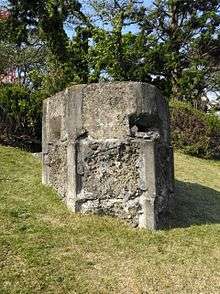
During the occupation, the base housed the overflow from nearby Camp Zama; it was not refurbished to handle military air traffic until the Korean War. The Seabees (Navy construction battalions) came to the base in 1950 and prepared it for re-opening that December as Naval Air Station Atsugi.
NAF Atsugi was a major naval air base during both the Korean War and Vietnam War, serving fighters, bombers, and transport aircraft.
One of the aircraft based at Atsugi at least since 1957[4] was the U-2 spy plane. The plane made local Japanese headlines when it ran low on fuel and made an emergency landing at a glider-club landing strip. This same plane was piloted by Gary Powers, which provoked an international incident when it was downed over the Soviet Union.[5]
Lee Harvey Oswald was based at Atsugi during his time in the United States Marines. He was a radar operator assigned to Marine Air Control Squadron 1.[6][7][8] He was stationed there from September 1957 to November 1958.[9]
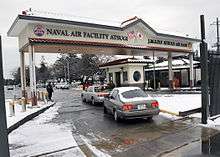
In 1964 a United States Marine Corps F8U-2 Crusader based at the airfield crashed in nearby Machida, Tokyo. The pilot ejected and was not seriously injured, but the crash killed four and injured 32 people on the ground and destroyed seven houses.[10]
In 1969 an EC-121 aircraft of VQ-1 that took off from Atsugi on a reconnaissance mission near North Korea was shot down by a North Korean MiG-21. This led then-president Nixon to order a tactical nuclear strike on North Korea, which ultimately did not take place.[11] The reconnaissance flights resumed a week later.
In 1972, the U.S. and Japanese governments agreed to share ownership of the base, after which the Japan Maritime Self Defence Force began operating from there.
In 1973 Yokosuka became the home port of the carrier USS Midway. As a consequence CVW-5, the carrier's air wing was based at Atsugi.[12][13][14]
On 2 November 1976, a US Navy Grumman C-1 Trader, piloted by Lt. Laury K. Backman, suffered a mechanical failure of the aileron system while maneuvering to land on runway 01, and crashed short of the runway. All six aboard were killed.[15]
In 1977, a McDonnell Douglas F-4 Phantom II based at the facility suffered a mechanical failure and crashed into a residential neighborhood in nearby Yokohama. The crew ejected and survived, but two young boys, aged 1 and 3, were killed and 7 others injured.[16]
Elements of the Naval Security Group and rotational squadrons of EP-3 Aries that are now stationed at Misawa Air Base were formerly stationed at Atsugi until the 1990s.
_landing_at_Naval_Air_Facility_Atsugi.jpg)
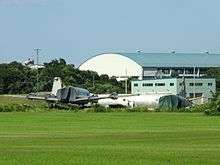
On 9 February 1999 a fire broke out at a terminal, no injuries were reported.[17]
On 3 April 2003 a faction of the leftist group Kakurōkyō attacked the facility with improvised mortar fire. Around the same time the same group also attacked Yokota Air Base and the National Defence Agency.[18]
In 2004 a McDonnell Douglas MD 900 Explorer operated by Aero Asahi made a crash-landing at Naval Air Facility Atsugi. There were no fatalities.[19][20]
On 14 November 2009 a fire in Hangar 183 at the base injured three Japanese employees of Obayashi Corporation. The fire was reported at 11:55 a.m. and was extinguished by 12:45 p.m. The hangar was moderately damaged.[21]
In December 2009, Atsugi was again attacked, this time by Kakurōkyō members via improvised mortar barrages.[22]
Personnel and aircraft from the base assisted with Operation Tomodachi following and during the March 2011 Tōhoku earthquake and tsunami and Fukushima I nuclear accidents. During the crisis, around 2,000 American family members voluntarily departed the base for locations outside Japan.[23]
On 16 December 2013 a MH-60S Knighthawk of CVW-5 crashed in Miura city due to a tail jam. The aircraft was written off and two of the four occupants were injured.[24][25]
On 15 February 2014 three US Navy P-3 Orions were crushed "beyond repair" when their hangar was destroyed due to a massive snow storm.[26][27]
In December 2016 police arrested a Kawasaki man for pointing a laser pointer at JMSDF aircraft in July of the same year. It was reported that in 2016 there had been about 30 reports of laser pointers being directed at Japanese and US aircraft.[28]
A Grumman C-2A Greyhound assigned to VRC-30 aboard the USS Ronald Reagan was lost in an accident at sea on 22 November 2017. Three of the personnel on board were lost.[29][30][31][32][33][34][35] After this a detachment of 4-6 US Marine Corps Bell Boeing V-22 Osprey tilt-rotor aircraft were deployed to Atsugi for a week to fly supplies to the USS Ronald Reagan.[36][37]
Base name
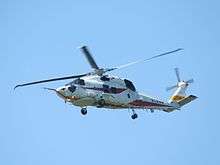
Atsugi is named after the nearby city of Atsugi despite not actually being in Atsugi (it is separated from Atsugi by two other cities).
The name was chosen because Atsugi was the only large town in the area as of 1950, and the three farming villages surrounding the base at that time—Yamato Village, Ayase Village and Shibuya Village—shared names with better-known areas elsewhere in Japan. Yamato is an alternative name for the Nara region, Ayase is generally associated with the area around Ayase Station in northeast Tokyo, and Shibuya is generally associated with the ward of Shibuya in central Tokyo.
Base issues
The Jinkanpo Incinerator
NAF Atsugi and the people stationed there gained notoriety in the 1990s (stemming from near-daily reports in the Pacific Stars and Stripes newspaper) due to their proximity to the Jinkanpo Atsugi Incinerator, which blew toxic and cancerous emissions over the high-rise buildings in its immediate vicinity. The incinerator's owners, arrested and jailed for charges of tax evasion, neglected the maintenance of the facility. The pollution had become so much of a health problem for residents that if they showed signs of adverse health effects, the base allowed them to leave early (usually servicemembers are stationed at the base for a tour of three years). Many servicemembers reported sickness and a few died from cancer shortly after moving back to the United States.[38] For a time, the base required servicemembers to undergo medical screenings before being stationed at the base in order to ensure that their bodies could handle the poor air quality. In spite of this, servicemembers still developed health problems, such as acute cases of asthma.
The US government's Department of Justice sued the incinerator operators.[39] In May 2001, just before the court was to hand down its decision, the Japanese government purchased the plant for nearly 40 million dollars and shut it down. Dismantling was completed by the end of that year.[40]
Noise lawsuits
Since 1976 there have been a number of lawsuits with local residents sued the Japanese government over noise from the base,[41] and in October 2002 the Yokohama district court ruled that the government should pay 2.75 billion yen in compensation. Both the plaintiffs and the government appealed the case and in July 2006 the Tokyo High Court ordered the government to pay 4.04 billion yen to 4,865 people living near the base.[42]
The fourth lawsuit over noise was filed in 2007 in the Yokohama District Court. In May 2014 the court ruled that the SDF should not operate its aircraft between 10pm to 6am and that the government should pay ¥7 billion yen in damages. It was the first lawsuit to request the grounding of US military aircraft. This request was rejected by the court.[43]
The ruling was appealed, and in its July 2015 ruling the Tokyo High Court gave ¥9.4 billion to around 6,900 residents from eight cities, increasing the payout from the ¥7 billion yen ordered by the Yokohama district court. The Tokyo court also rejected calls to forbid night flights by US aircraft, arguing that the Japan-US security treaty is beyond the government's jurisdiction. In this it was following a Supreme Court ruling on the 1976 case, where the court ruled that the Japanese government has no power to regulate the activities of US forces in the country.[44][45]
The case was appealed to the Supreme Court and in December 2016 Japan's Supreme Court overturned the ban on SDF night flights. It upheld the damages awarded by the Tokyo High Court. The plaintiffs planned to file a fifth lawsuit as soon as February 2017.[46]
Organizing by residents continued[47] and in July 2017 it was reported that there were plans for around 6,000 local people to launch the fifth lawsuit against the government regarding noise from the base. Shuji Onami, leader of the plaintiffs, stated "Our lives are disrupted and are even put at risk whenever we are hit with booming noise (from aircraft) overhead. We will never accept the reality of the Atsugi base-related flights." It was also reported that 2,000 to 3,000 additional residents may also join the action at a later time.[48]
As of August 2017 6,063 nearby residents had joined the lawsuit.[49]
Protests and complaints
In addition to the lawsuits over noise there have been a number of protests regarding the base. In July 1988 20,000 people made a human chain around the base to protest noisy night landings at the base.[50][51]
In 2005 Yamato city officials protested noisy night landings from F/A-18 Hornet training.[52]
In 2007 the Japanese Communist Party (JCP) protested F-16 and F/A-18 exercises at the base and asked that they be stopped.[53]
In 2013 the JCP also protested after a USN MH-60S Seahawk helicopter from Atsugi crashed in Miura city, and asked that Bell Boeing V-22 Ospreys not be deployed to Atsugi.[54] When Ospreys were sent to the base for training this also caused local protests.[55]
There were complaints in 2017 after children were allowed to touch machine guns on US helicopters during the May 2017 open day at Atsugi. City authorities from Ayase and Yamato cities complained, after which the machine guns were quickly removed.[56]
Friendship festival
During Spring Atsugi holds an open day. Non-Japanese visitors may be turned away from the gates for security reasons. Prospective attendees who are neither Japanese or American should bring identification and also consult the Third Country National list to see if they require special approval to enter the base.
There was an "Atsugi WINGS" air show held until the year 2000, featuring the "diamond of diamonds" display by formations of US Navy aircraft.[57][58] This was last held in the year 2000. There were many complaints about aircraft noise and low-flying planes, and from 2001 onwards full-fledged flying displays were not held during the open day.[59] Currently there is a ground display of US Navy and JMSDF aircraft, as well as take-offs and landings by various aircraft, including touch-and-go landing practice.
Carrier Air Wing Five
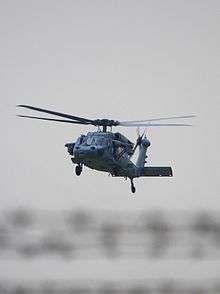
Atsugi hosts part of Carrier Air Wing Five, part of aircraft carrier USS Ronald Reagan's air component. The wing includes about 70 aircraft and 2,000 military personnel who are stationed at Atsugi when the carrier is in port at Yokosuka. On 9 May 2008 the wing commander, Captain Michael P. McNellis, was relieved of command by Rear Admiral Richard B. Wren, commander of Commander Task Force 70, after the admiral said he lost confidence in McNellis' ability to command. McNellis was replaced by Captain Michael S. White.[60][61] In 2012 the squadrons of CVW 5 completed their transition to variants of the Super Hornet/Growler, making it the first air wing without legacy Hornets.[62]
Relocation to Iwakuni
Since at least 2005 there have been plans to relocate Carrier Air Wing Five's approximately 60 fixed wing aircraft from Atsugi to Marine Corps Air Station Iwakuni in Yamaguchi prefecture.[63] Yamaguchi governor Sekinari Nii said there was "no way" Yamaguchi prefecture would accept this.[64] In 2006 Iwakuni voters rejected the plan in a plebiscite[65] and Iwakuni mayor Katsusuke Ihara urged Tokyo to drop the plan.[66] In 2007 the Japanese government passed legislation to prepare for the relocation of US Forces in Japan including subsidies for local affected areas.[67]
The move was planned to have been done in 2014, but after construction delays the move was delayed by three years, to 2017.[68][69][44]
The plan was for the move to take place in stages and be completed in May 2018.[70] The move did not include the wing's approximately 20 helicopters.
The move began in August 2017 with the five E-2D Hawkeye aircraft of VAW-125 relocating to Iwakuni after the USS Ronald Reagan's summer 2017 patrol. Around 3800 personnel are expected to move to Iwakuni.[71]
By 28 November three more squadrons relocated after the Ronald Reagan's second patrol of 2017. The new squadrons were the F/A-18E Super Hornet-equipped VFA-115[72] and VFA-195 and the EA-18G Growler-equipped VAQ-141.[73] Fleet Logistics Support Squadron VRC-30 also relocated to MCASI by December 2017.
In March 2018 strike fighter squadrons VFA-27 and VFA-102 arrived at MCAS Iwakuni, completing the move of CVW-5's fixed-wing aircraft squadrons.[74]
Tenant squadrons
Maritime Self Defence Force
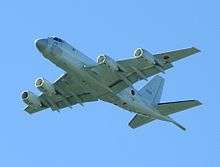
As of 2018, the following Fleet Air Force units of the Japanese Maritime Self Defence Force units are based at NAF Atsugi:[75][76]
US Navy
As of 2018, the US Navy tenant commands at NAF Atsugi are:[77]
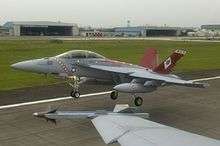
Carrier Air Wing Five: (The fixed-wing squadrons have relocated to Marine Corps Air Station Iwakuni)
- Helicopter Maritime Strike Squadron 77 Saberhawks (MH-60R Seahawk) (to remain at Atsugi, will not relocate to Iwakuni)
- Helicopter Sea Combat Squadron 12 Golden Falcon (MH-60S Seahawk) (to remain at Atsugi, will not relocate to Iwakuni)
- Fleet Readiness Center Western Pacific
See also
- Izumi no Mori, a nature park operated by the city of Yamato, is located near the base.
References

- Maurer, Maurer (1983). Air Force Combat Units of World War II. Maxwell AFB, Alabama: Office of Air Force History. ISBN 0-89201-092-4.
- AFHRA History search Atsugi
- Biographies Retrieved 17 August 2016
- NAF Atsugi (official site)
- AIS Japan Archived 17 May 2016 at the Portuguese Web Archive
- "FUTURE PLANS FOR PROJECT AQUATONE/OILSTONE". Central Intelligence Agency. 29 July 1957. p. 2. Archived from the original (gif) on 8 March 2012. Retrieved 12 June 2010.
- Powers, Francis (1960). Operation Overflight: A Memoir of the U-2 Incident. Potomac Books, Inc. p. 43,49–50,94. ISBN 9781574884227.
- Appendix 13 National Archives Retrieved 19 February 2017
- 8 Things You May Not Know About Lee Harvey Oswald 19 November 2013 PBS Retrieved 19 February 2017
- American Experience : Oswald's Ghost PBS Retrieved 19 February 2017
- JFK Assassination: Just Who Was Lee Harvey Oswald? 18 November 2013 International Business Times Retrieved 19 February 2017
- Associated Press (6 April 1964). "U.S. Plane in Japan Kills Four in Crash". The New York Times. p. 7.
- Shutter, Mike Nixon Considered Nuclear Option Against N. Korea 6 July 2017 NPR'' Retrieved 22 June 2017
- Living With the Nightmare of Planes and Aircraft Carriers at U.S. Bases in Japan: Upgrading Iwakuni and Yokosuka 7 April 2008 Chugoku Shimbun Retrieved 10 December 2016
- Plaintiffs in Atsugi base airplane noise lawsuit irked by Supreme Court ruling 9 December 2016 Mainichi Shimbun Retrieved 10 December 2016
- History CNIC Retrieved 10 December 2016
- personal knowledge, contributor is son of pilot
- Hirano, Keiji (Kyodo News) (28 September 2012). "Group saves records of fatal U.S. fighter jet crash". Japan Times. Retrieved 28 September 2012.
- Atsugi naval warehouse catches fire 9 February 1999 Japan Times Retrieved 10 August 2016
- Yoshida, Reiji Leftist group raided after projectile attack 19 February 2004 Japan Times Retrieved 10 August 2016
- ASN Wikibase Occurrence # 58524 Date: 14-SEP-2004 Aviation Safety Network Retrieved 28 February 2017
- AIRCRAFT ACCIDENT INVESTIGATION REPORT 26 January 2007 Aircraft and Railway Accidents Investigation Commission Ministry of Land, Infrastructure and Transport Retrieved 28 February 2017
- Stars and Stripes, "Hangar fire at Atsugi injures 3", 16 November 2009.
- Slavin, Erik; Kusumoto, Hana (21 October 2010). "Japanese police raid operational bases of anti-U.S. military group". Stars and Stripes. Retrieved 12 September 2018.
- Reed, Charlie, "Military wraps up first round of departures from Japan", Stars and Stripes, 25 March 2011, retrieved 28 March 2011.
- ASN Wikibase Occurrence # 162748 Retrieved 27 August 2016
- Slavin, Erik US Navy helicopter crashes south of Yokosuka 16 December 2013 Stars and Stripes Retrieved 27 August 2016
- "Three US navy planes crushed in Japan snow". AFP. 7 May 2014. Archived from the original on 10 May 2014. Retrieved 16 July 2016.
- "Navy Orions likely damaged in hangar collapse". Stars and Stripes. 18 February 2014. Retrieved 9 May 2014.
- Kawasaki man arrested for pointing laser beam at MSDF aircraft 1 December 2016 Japan Times Retrieved 1 December 2016
- "US Navy C-2 Greyhound crashes in Philippine Sea". Flight Global. 22 November 2017. Retrieved 23 November 2017.
- "U.S. Navy plane crashes in Philippine Sea, three missing". Reuters. 22 November 2017. Retrieved 22 November 2017.
- Rich, Motoko (22 November 2017). "Navy Aircraft With 11 Aboard Crashes into Waters Off Japan". The New York Times. Retrieved 22 November 2017.
- Lockie, Alex (22 November 2017). "US Navy plane carrying 11 crashes in the Philippine Sea en route to aircraft carrier". businessinsider.com. Business Insider. Retrieved 23 November 2017.
- Walters, Joanne (23 November 2017). "Three missing after US navy plane crashes in Philippine Sea". The Guardian. Retrieved 23 November 2017.
- Cenciotti, David (22 November 2017). "U.S. Navy C-2A Aircraft Carrying 11 Crew And Passengers Crashed in the Ocean Southeast of Okinawa". theaviationist.com. Retrieved 23 November 2017.
- "Search Ends For Sailors in C-2A Crash". navy.mil. 23 November 2017. Retrieved 25 November 2017.
- "厚木飛行場等へのMV-22オスプレイの飛来情報について". mod.go.jp. 24 November 2017. Retrieved 27 November 2017.
- "海兵隊MV-22、11月25日から12月3日にCVN-76と厚木飛行場間で飛行". flyteam.jp (in Japanese). 24 November 2017. Retrieved 27 November 2017.
- Hesse, Stephen Is the Atsugi tragedy finally drawing to a close? 28 February 2010 Japan Times Retrieved 26 August 2016
- Hesse, Stephen U.S. sues Atsugi incinerator operator 12 February 2001 Japan Times Retrieved 11 August 2016
- Hesse, Stephen Is this a poisons coverup? 27 June 2007 Japan Times Retrieved 11 August 2016
- Hanai, Kiroku Noisy assaults on living 27 October 2008 Japan Times Retrieved 10 August 2016
- Hongo, Jun 4 billion yen awarded for Atsugi base noise 14 Jul 2006 Japan Times
- In shock decision, Yokohama court halts SDF night flights at base shared with U.S. 21 May 2014 Japan Times Retrieved 9 December 2016
- Reducing military jet noise 9 August 2015 Japan Times Retrieved 10 August 2016
- High court upholds ban on SDF night flights at Atsugi, lets U.S. off the hook 30 July 2016 Japan Times Retrieved 9 December 2016
- Supreme Court overturns ruling to suspend nighttime SDF flights at Atsugi air base 8 December 2016 Japan Times Retrieved 9 December 2016
- Yoshimura, Shigeo Residents near Atsugi base rise up again to fight aircraft noise 7 April 2017 Asahi Shimbun Retrieved 14 August 2017
- Thousands of residents near Atsugi air base plan to sue Japan again over noise pollution 22 July 2017 Japan Times Retrieved 14 August 2017
- Yoshimura, Shigeo Thousands sue over noise levels at nation’s 'most dangerous’ base 5 August 2017 Asahi Shimbun Retrieved 31 August 2017
- Quiet Protest and US Base 25 July 1988 LA Times Retrieved 27 August 2016
- 20,000 protest at U.S. base in Japan 24 July 1988 Lakeland Ledger Retrieved 27 August 2016
- Atsugi F/A-18 training draws noise protest from city officials 22 May 2005 Stars and Stripes Retrieved 27 August 2016
- JCP protests U.S. forces’ exercises with F-16s and FA-18s at Atsugi 11 December 2007 Akahata Retrieved 27 August 2016
- JCP in Kanagawa protests against US military copter crash December 2013 Japan Press Weekly Retrieved 27 August 2016
- Ospreys fly to Atsugi base again en route to training 19 August 2014 Japan Times Retrieved 27 August 2016
- U.S. military festival in Kanagawa criticized for letting kids touch machine guns 2 May 2017 Mainichi Shimbun Retrieved 14 August 2017
- "厚木基地オープンハウス WINGS'93 Fleet Fly-By 1/2 NAF Atsugi Air Show". youtube.com. 29 December 2011. Retrieved 8 November 2017.
- "Diamond of diamonds WINGS '99 NAF Atsugi (Japan)". youtube.com. 10 November 2008. Retrieved 8 November 2017.
- Makoto Morimoto (2001). "NAF / JMSDF Atsugi Airshow "Wings"". geocities.jp. Retrieved 8 November 2017.
- Weaver, Teri, "Kitty Hawk Air Wing Commander Removed For 'Loss of Confidence'", Stars and Stripes, 11 May 2008.
- Commander Carrier Air Wing 5 Relieved of Command 9 May 2008 Navy.mil Retrieved 10 August 2016
- Stewart, Joshua Corps to base F-35s in Asia-Pacific region 21 January 2015 Marine Times Retrieved 11 August 2016
- Iwakuni to take in Atsugi jets? 4 Jun 2005 Japan Times Retrieved 10 August 2016
- Yamaguchi governor rips Iwakuni move 31 October 2005 Japan Times Retrieved 10 August 2016
- Johnston, Eric Iwakuni voters reject realignment plan 13 Mar 2006 Japan Times
- Drop base plan: Iwakuni mayor 17 March 2006 Japan Times Retrieved 10 August 2016
- Diet enacts law that paves way for U.S. forces realignment 24 May 2007 Japan Times Retrieved 10 August 2016
- Air wing's move from Atsugi to Iwakuni delayed 3 years 25 January 2013 Stars and Stripes Retrieved 10 August 2016
- Moriyasu, Ken US Navy needs touch-and-go practice strip 13 May 2016 The Nikkei Retrieved 31 August 2016
- Suga visits Yamaguchi for consent to transfer U.S. carrier wing to base in Iwakuni 5 February 2017 Japan Times Retrieved 5 February 2017
- US aircraft transfer to Iwakuni begins under realignment plan 9 August 2017 Archived 14 August 2017 at the Wayback Machine Mainichi Shimbun Retrieved 14 August 2017
- Pagenkopf, Chris (22 September 2017). "VFA-115 closes out 31 years of operations at NAF Atsugi". cpf.navy.mil. Retrieved 21 April 2018.
- "Initial Japan-Based Carrier Air Wing-5 Jet Squadrons Fly-in to Marine Corps Air Station Iwakuni". mcasiwakuni.marines.mil. 28 November 2017. Retrieved 2 December 2017.
- "Final Japan-Based CVW-5 Jet Squadrons Fly-in to MCAS Iwakuni". 28 March 2018. Retrieved 19 April 2018.
- 厚木航空基地 Retrieved 8 February 2017 (in Japanese)
- Thompson, Paul JMSDF Order of Battle J-HangarSpace Retrieved 8 February 2017
- NAF Atsugi: Tenant commands Retrieved 10 August 2016
External links
| Wikimedia Commons has media related to Naval Air Facility Atsugi. |